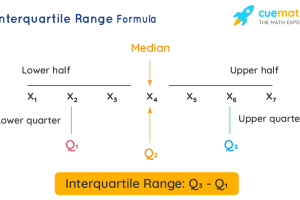Why people like to use IQR calculator

IQR (Interquartile Range) is a widely used statistical measurement that represents the spread of values within a data set. The IQR is a measure of variability, based on dividing a data set into quarters. Calculating the IQR is a key step in identifying outliers and assessing the skewness of a data set. The IQR is used in a variety of fields, including finance, medicine, and social sciences, to make informed decisions about data.
What is an IQR Calculator?
An IQR calculator is a tool used to quickly and easily calculate the IQR of a data set. The IQR calculator takes in a list of values and returns the IQR as well as other important values such as the lower quartile (Q1), upper quartile (Q3), and median. IQR calculators come in different forms, from simple online calculators to sophisticated software packages. Regardless of the form, the basic principle behind an IQR calculator remains the same: to simplify the calculation of the IQR.
Using the IQR calculator, you can quickly and easily find the IQR of your data set. The IQR will give you an idea of the spread of the data, which can be useful in determining whether or not the data is skewed. If the IQR is small, it means that the data is tightly packed and is not very spread out. On the other hand, if the IQR is large, it means that the data is spread out and there is a lot of variability in the data. The IQR can also be used to detect outliers, as outliers are defined as values that are more than 1.5 times the IQR away from either Q1 or Q3.
How to Use an IQR Calculator?
Using an IQR calculator is simple and straightforward. Here are the steps to follow when using an IQR calculator:
Input Data: The first step is to input the data set into the IQR calculator. This can be done by either entering the data manually or uploading a file containing the data.
Calculate IQR: Once the data is input, the IQR calculator will automatically calculate the IQR, Q1, Q3, and median.
Interpret Results: The results of the calculation will be displayed in a table or graph. The IQR is usually represented as a range or distance between the lower and upper quartiles.
Identify Outliers: One of the key uses of the IQR is to identify outliers in a data set. Outliers are values that fall outside of the IQR and can skew the data. To identify outliers, use the formula Q1 – 1.5 * IQR and Q3 + 1.5 * IQR. Any value that falls outside of this range is considered an outlier.
Benefits of Using an IQR Calculator
Accuracy: An IQR calculator eliminates the potential for human error in manual calculations. This is especially important in large data sets where manual calculations can become time-consuming and prone to error.
Speed: An IQR calculator calculates the IQR and other values quickly, saving time and allowing for quicker analysis of data.
Consistency: An IQR calculator ensures consistency in the calculation of the IQR, which is important in comparing data sets or tracking changes in data over time.
Conclusion
The IQR is an important statistical measurement that represents the spread of values within a data set. An IQR calculator simplifies the calculation of the IQR, allowing for quicker and more accurate analysis of data. Whether you are a statistician, data analyst, or student, an IQR calculator is a valuable tool that should be in your arsenal. The IQR calculator is an online tool that calculates the IQR of a given set of numerical data. It can be used to find the IQR of a small or large data set, as well as to calculate the outliers in a data set. The IQR calculator can be found on many websites and is often free to use. To use an IQR calculator, you simply need to input the data set into the calculator, and the calculator will do the rest.